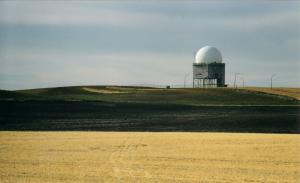
Village, pop 178, located just inside the Alberta-Saskatchewan border, W of Kindersley on Hwy 7. Settlement of the district began around 1909, and by 1916 the population was over 300. The 1930s hit the region hard, however, and by World War II the town had lost a third of its citizens. In 1959, the village’s fortunes changed when RCAF Station Alsask was conceived as part of an early warning radar system deemed integral to North American air defence against Soviet missiles and bombers. Construction of the 418-acre military facility adjacent to the north side of the village began in 1961, and in early 1963 the long-range radar unit, 44 Radar Squadron, was operational. The station later became known as CFD (Canadian Forces Detachment) Alsask. The base included three radar domes, housing, a school, a swimming pool, and the first cable television in the province. It was staffed by 125 service personnel, many of whom lived on site with their families, as well as 60 civilian employees. The village of Alsask was transformed by the activity and the combined population was over 800 in the early 1970s. The disbanding of the station in 1987 had a major impact on Alsask, as hundreds of people were gone within months. Few businesses remain in the community today. The one remaining radar dome, built in 1961, was designated a heritage property in 2002. Today, agriculture as well as and oil and gas are the major industries in the area.
David McLennan
Print EntryMcLennan, David. 2008. Our Towns: Saskatchewan Communities from Abbey to Zenon Park. Regina: Canadian Plains Research Center.
HOME | BROWSE BY SUBJECT | ENTRY LIST (A-Z) | IMAGE INDEX | CONTRIBUTOR INDEX | ABOUT THE ENCYCLOPEDIA | SPONSORS TERMS OF USE | COPYRIGHT © 2006 CANADIAN PLAINS RESEARCH CENTER, UNIVERSITY OF REGINA | POWERED BY MERCURY CMS |
|||
| This web site was produced with financial assistance provided by Western Economic Diversification Canada and the Government of Saskatchewan. |
|||
 |
 |
 |
 |
| Ce site Web a été conçu grâce à l'aide financière de Diversification de l'économie de l'Ouest Canada et le gouvernement de la Saskatchewan. |
|||